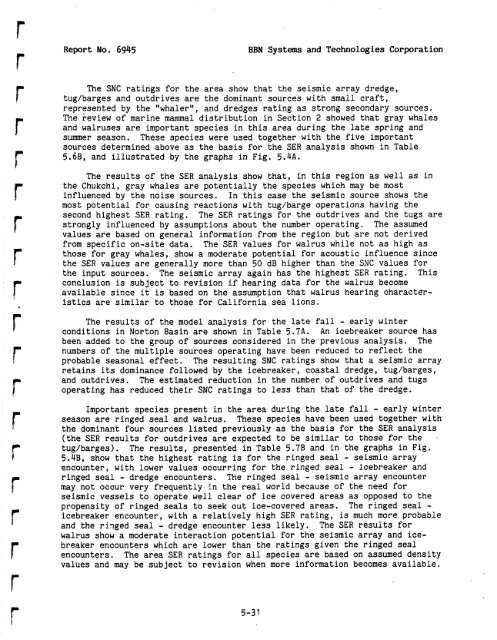Analysis and Ranking of the Acoustic Disturbance Potential of ...
Analysis and Ranking of the Acoustic Disturbance Potential of ...
Analysis and Ranking of the Acoustic Disturbance Potential of ...
You also want an ePaper? Increase the reach of your titles
YUMPU automatically turns print PDFs into web optimized ePapers that Google loves.
Report No. 6945<br />
BBN Systems <strong>and</strong> Technologies Corporation<br />
The SNC ratings for <strong>the</strong> area show that <strong>the</strong> seismic array dredge,<br />
tug/barges <strong>and</strong> outdrives are <strong>the</strong> dominant sources with small craft,<br />
represented by <strong>the</strong> "whaler", <strong>and</strong> dredges rating as strong secondary sources.<br />
The review <strong>of</strong> marine mammal distribution in Section 2 showed that gray whales<br />
<strong>and</strong> walruses are important species in this area during <strong>the</strong> late spring <strong>and</strong><br />
summer season. These species were used toge<strong>the</strong>r with <strong>the</strong> five important<br />
sources determined above as <strong>the</strong> basis for <strong>the</strong> SER analysis shown in Table<br />
5.6B, <strong>and</strong> illustrated by <strong>the</strong> graphs in Fig. 5.4A.<br />
The results <strong>of</strong> <strong>the</strong> SER analysis show that, in this region as well as in<br />
<strong>the</strong> Chukchi, gray whales are potentially <strong>the</strong> species which may be most<br />
influenced by <strong>the</strong> noise sources. In this case <strong>the</strong> seismic source shows <strong>the</strong><br />
most potential for causing reactions with tug/barge operations having <strong>the</strong><br />
second highest SER rating. The SER ratings for <strong>the</strong> outdrives <strong>and</strong> <strong>the</strong> tugs are<br />
strongly influenced by assumptions about <strong>the</strong> number operating. The assumed<br />
values are based on general information from <strong>the</strong> region but are not derived<br />
from specific on-site data. The SER values for walrus while not as high as<br />
those for gray whales, show a moderate potential for acoustic influence since<br />
<strong>the</strong> SER values are generally more than 50 dB higher than <strong>the</strong> SNC values for<br />
<strong>the</strong> input sources. The seismic array again has <strong>the</strong> highest SER rating. This<br />
conclusion is subject to revision if hearing data for <strong>the</strong> walrus become<br />
available since it is based on <strong>the</strong> assumption that walrus hearing characteristics<br />
are similar to those for California sea lions.<br />
The results <strong>of</strong> <strong>the</strong> model analysis for <strong>the</strong> late fall - early winter<br />
conditions in Norton Basin are shown in Table 5.7A. An icebreaker source has<br />
been added to <strong>the</strong> group <strong>of</strong> sources considered in <strong>the</strong> previous analysis. The<br />
numbers <strong>of</strong> <strong>the</strong> multiple sources operating have been reduced to reflect <strong>the</strong><br />
probable seasonal effect. The resulting SNC ratings show that a seismic array<br />
retains its dominance followed by <strong>the</strong> icebreaker, coastal dredge, tug/barges,<br />
<strong>and</strong> outdrives. The estimated reduction in <strong>the</strong> number <strong>of</strong> outdrives <strong>and</strong> tugs<br />
operating has reduced <strong>the</strong>ir SNC ratings to less than that <strong>of</strong> <strong>the</strong> dredge.<br />
Important species present in <strong>the</strong> area during <strong>the</strong> late fall - early winter<br />
season are ringed seal <strong>and</strong> walrus. These species have been used toge<strong>the</strong>r with<br />
<strong>the</strong> dominant four sources listed previously as <strong>the</strong> basis for <strong>the</strong> SER analysis<br />
(<strong>the</strong> SER results for outdrives are expected to be similar to those for <strong>the</strong> .<br />
tug/barges).<br />
The results, presented in Table 5.7B <strong>and</strong> in <strong>the</strong> graphs in Fig.<br />
5.4B, show that <strong>the</strong> highest rating is for <strong>the</strong> ringed seal - seismic array<br />
encounter, with lower values occurring for <strong>the</strong> ringed seal - icebreaker <strong>and</strong><br />
ringed seal - dredge encounters. The ringed seal - seismic array encounter<br />
may not occur very frequently in <strong>the</strong> real world because <strong>of</strong> <strong>the</strong> need for<br />
seismic vessels to operate well clear <strong>of</strong> ice covered areas as opposed to <strong>the</strong><br />
propensity <strong>of</strong> ringed seals to seek out ice-covered areas. The ringed seal -<br />
icebreaker encounter, with a relatively high SER rating, is much more probable<br />
<strong>and</strong> <strong>the</strong> ri2ged seal - dredge encounter less likely. The SER results for<br />
walrus show a moderate interaction potential for <strong>the</strong> seismic array <strong>and</strong> icebreaker<br />
encounters which are lower than <strong>the</strong> ratings given <strong>the</strong> ringed seal<br />
encounters. The area SER ratings for all species are based on assumed density<br />
values <strong>and</strong> may be subject to revision when more information becomes available.
















